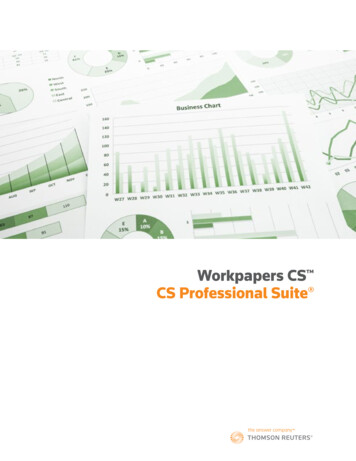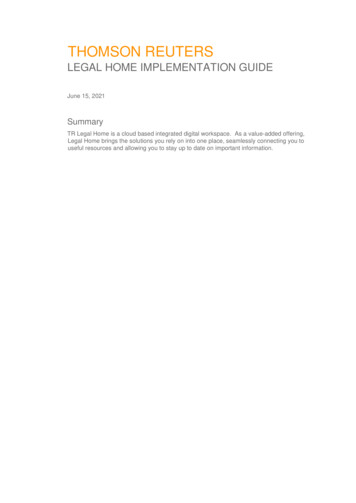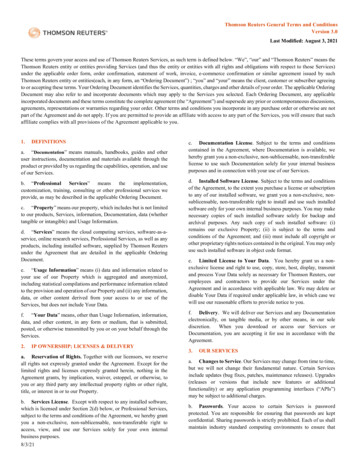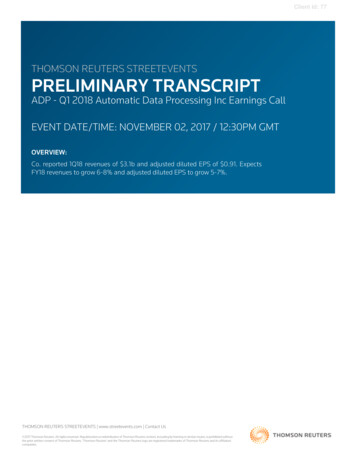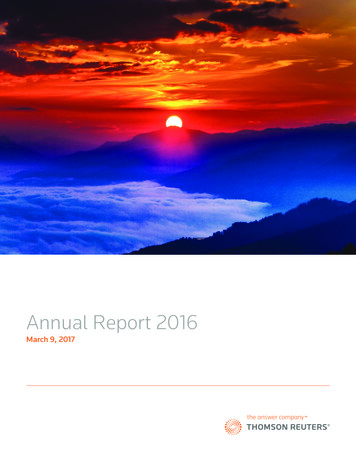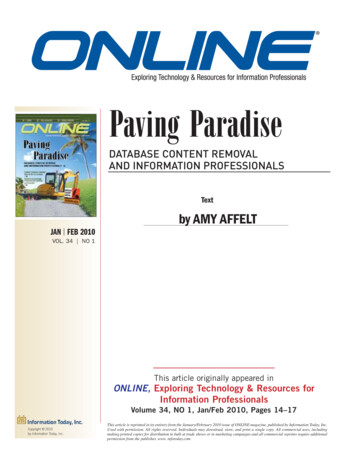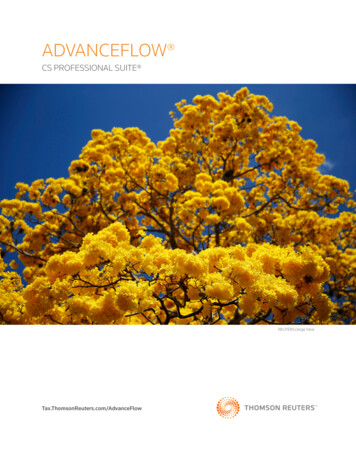
Transcription
Content SamplerCauses of Action, Defences and RemediesProof of Facts
Begin case and trial preparationwith a better starting pointFrom the general to the specificTake for example assessing a case where Occupier’sLiability is a consideration.Causes of Action, Defences and Remedies provides comprehensivematerials on the general law of occupier’s liability. Proof of Facts offersmaterials for specific fact scenarios in which occupier’s liability may occur Inadequate Protection of Spectator at Sporting Event – Proof of NegligentOperation of Boxing Gymnasium, Martial Arts School or Establishment;and – Landlord’s Liability for Injury by Tenant’s Dog.From strategy to trialCauses of Action, Defences and Remedies aides in the determination ofwhether to commence an action involving occupier’s liability and includesguidance in the discovery process, pleadings, as well as factum writing.Proof of Facts also aides in the determination of whether to commencean action involving occupier’s liability within the fact scenario and providesdirection for proving the elements of occupier’s liability through sampletestimony including questions and answers.Learn more visit www.westlawnextcanada.com/strategic2
CONTENTSCauses of Action, Defences and Remedies 4Occupier’s Liability (Excerpt)Proof of Facts 8Liability in the operation of a boxing gymnasium, martial arts centre,fitness centre, or similar establishment (Excerpt)
Causes of Action, Defences,and RemediesCauses of Action, Defences and Remedies is a collection ofarticles, or ‘toolkits’, each focused on a specific cause of action.Each toolkit provides an overview of the causeof action and includes leading cases, relevantlegislation, checklists, related defences, andsecondary source references. Confidently and quickly identify all relevantcase law and elements of a particular causeof action from across all Canadian courts Plot case strategy from both perspectives Draft pleadings that are more focused,precise, succinct, and thorough—andplan examinations for discovery and attrial more efficientlyLearn more visit www.westlawnextcanada.com/strategic4
5Excerpt from Causes of Action, Defencesand Remedies article Occupier’s Liability1. OVERVIEWa) Requisite elements to establish a claim for occupier’s liabilityb) Leading court decisions on occupier’s liabilityc) Relevant legislation (including rules of court)d) Limitation periodse) Burden of prooff) Remediesg) Summary judgmenth) Costsi) Practice tipsj) Related causes of action, defences, and remedies2. MODEL PLEADING LANGUAGEa) Model language for pleading occupier’s liability in a statement of claimb) Model language for denying occupier’s liability in a statement of defencec) Model factum language for party arguing issues of occupier’s liability3. PRACTICE CHECKLISTSa) Checklists for litigants where issues of occupier’s liability raisedb) Examinations for discovery questions and strategies4. RESEARCH REFERENCESa) Booksb) Articlesc) Canadian Encyclopedic Digest (CED)d) WestlawNext Canada Legal Memorandae) Canadian Abridgment case digests
1. OVERVIEWa) Requisite elements to establish a claim for occupier’s liabilityOccupier’s liability is an area of law of negligence concerning the duty owed by a personhaving control over premises such that he should realize that any failure to take care mayresult in injury to a person coming lawfully onto the premises: Daphne Dukelow, TheDictionary of Canadian Law, 4th ed. (Toronto: Carswell, 2011), at 872.In British Columbia, Alberta, Manitoba, Ontario, Nova Scotia, and Prince Edward Island,occupier’s liability is governed by legislation. Under section 3(1) of the Ontario Occupiers’Liability Act, R.S.O. 1990, c. O.2, for example, an occupier of premises owes a duty to “takesuch care as in all the circumstances of the case is reasonable to see that persons entering onthe premises, and the property brought on the premises by those persons are reasonably safewhile on the premises”.In the remaining common-law jurisdictions, occupier’s liability will be governed by commonlaw principles, described by the Newfoundland Court of Appeal as “archaic, cumbersome, andoften unfair”: Stacey v. Anglican Churches of Canada (Diocesan Synod of Eastern Newfoundland& Labrador) (1999), 1999 CarswellNfld 278, 182 Nfld. & P.E.I.R. 1, 47 C.C.L.T. (2d) 153, 554A.P.R. 1 (Nfld. C.A.), at para. 28 ” [ ]2. MODEL PLEADING LANGUAGEa) Model language for pleading occupier’s liability in a statement of claimSet out in this section is model language for pleading occupier’s liability in a statement ofclaim or notice of civil claim.For model language to plead defences to claims of occupier’s liability, see section 2(b). Rulesfor pleading tort claims.For rules of court governing the pleading of tort claims in a statement of claim or notice of civilclaim (including pleading occupier’s liability), see section 1(c)(ii) regarding the need to: Plead the effect of a document or the purport of a conversation, including the actual wordsused, if material Plead particulars of any allegations of fraud, misrepresentation, breach of trust, malice, orintent Plead the amount of general damages, except for those jurisdictions where doing so is notallowedThe model pleading language that follows assumes you already have the appropriate formof statement of claim or other pleading and have set out the required style of cause and anypreliminary averments and other causes of action as required by the particular situation.Included with the model language below are headings in bolded text, something that isrecommended for each major cause of action or defence being raised in your pleading as ameans of providing “signposts” or visual clues for your reader. [ ]Learn more visit www.westlawnextcanada.com/strategic6
73. PRACTICE CHECKLISTSa) Checklists for litigants where issues of occupier’s liability raisedFor litigation checklists more generally, including the need for client verification and clearingconflicts of interests, retainer agreements, tickler systems (to avoid missing potential limitationperiods), and other issues of civil procedure, see the following litigation checklists on Litigator: Alberta Civil Litigation Checklists British Columbia Civil Litigation Checklists Manitoba Civil Litigation Checklists Gannage’s Ontario Civil Litigation Checklists Saskatchewan Civil Litigation ChecklistsOtherwise, for checklists specific to occupier’s liability claims, consider adapting the foregoinglitigation checklists at the various stages of the lawsuit [ ]4. RESEARCH REFERENCESa) BooksSet out below are books that provide commentary on occupier’s liability, organized into thefollowing categories:(i) Tort law books(ii) Municipal law books(iii) Law reform commission reports(iv) Books from the United Kingdom, the United States, and Australia [ ]b) ArticlesThe following articles provide a good overview on occupier’s liability, organized into thefollowing two broad categories:(i) Articles on occupier’s liability more generally(ii) Articles on commercial and social host liability [ ]c) WestlawNext Canada Legal MemorandaWestlawNext Canada Legal Memoranda on the topic of occupier’s liability are found under thefollowing main heading: TOR.XVI.8: Torts—Negligence—Occupiers’ liability [ ]d) Canadian Abridgment case digestsCases dealing with occupier’s liability are digested under the following main classificationscheme in the Canadian Abridgment: TOR.XVI.8: Torts—Negligence—Occupiers’ liability [ ]
Proof of Facts collectionQuickly gather the evidence that matters, prepare for questioningwitnesses more efficiently and save time on drafting examinationand cross-examination questionsWestlawNext Canada’s Proof of Facts helps you hone in on exactly what youneed to prove in order to win your case. It consists of a collection of detailedarticles which identify the facts essential to winning a case and suggestsstrategies for how to prove them.Proof of Facts articles have many aids including: Sample Trial and Discovery Questions, Pleadingsand Checklists – covering every stage of trial preparationto help you identify potential challenges in proving your case Broad range of civil litigation topics covering both familiarand emerging probative issues Search box to help you quickly find the topicNever overlook an element of a caseand feel confident that you have coveredthe necessary probative issues Determine what to prove and how to prove itto win your caseFind relevant sample questions and checklists quicklyPrepare for questioning witnessesLink to supporting case law for easy referenceLess wasted timedrafting examinationand cross-examination questionsonProof of Facts is fully integrated intoWestlawNext Canada giving you access to exclusivecontent such as secondary sources, Practical Law Canada andadvance search functionality and folders to save your work.For more information, visit www.westlawnextcanada.com/strategic8
9Excerpt from Proof of Facts article Liability in theoperation of a boxing gymnasium, martial artscentre, fitness centre, or similar establishmentLEGAL BACKGROUND1. Introduction2. The elements of Occupier’s Liability3. Defences to Occupier’s Liability Actions4. Occupier’s Liability Cases within the Context of Gyms5. Additional Litigation ConsiderationsDAMAGES AND OTHER REMEDIES6. Damages Generally7. Checklist for DamagesELEMENTS OF PROOF8. General9. Checklist of Evidence for Occupier’s Liability in a Boxing Gymnasium,Martial Arts School or Similar GymMODEL DISCOVERY10. Plaintiff’s Examination for Discovery Questionsto Defendant Facility Operator11. Plaintiff’s Examination for Discovery Questions to Employee of BoxingGymnasium or Martial Arts12. Defendant’s Examination for Discovery Questions to Plaintiff13. Plaintiff’s Request for Production of Documents14. Defendant’s Request for Production of DocumentsPROOF OF NEGLIGENT OPERATION OF BOXING GYMNASIUM MARTIALARTS SCHOOL OR SIMILAR ESTABLISHMENTA. Proof of Negligence in Allowing Martial Arts Student to Spar15. Testimony of plaintiff16. Testimony of expert witnessB. Proof of Boxer’s Contributory Negligence and Assumption of Risk17. Testimony of Gymnasium Manager
I. LEGAL BACKGROUND1. IntroductionLEGAL ISSUE:This article explores the liability in negligence for owners and operators of various gymfacilities, the defences available, and the assessment of damages.Liability in the operation of a boxing gymnasium, martial arts centre, fitness centre, orsimilar establishment (“gym” for the purposes of this article) primarily falls under the areaof occupier’s liability, which is governed both by statute and common law, depending on theprovincial jurisdiction.Historically at common law, occupier’s liability classified those persons attending property intodifferent categories, with different duties of care for each. Contractual entrants are owed thehighest duty of care, followed by invited guests, then licensees, and finally trespassers. Theduty of care lessens with each category: Klar, Lewis N. Remedies in Tort. (Toronto: ThomsonReuters, 2018) [Klar] at ch. 18.I.1.a, ss. 1. Common law principles have evolved to more closelyresemble standard negligence duty of care. Of the provinces and territories in Canada,Saskatchewan still relies on common law occupier’s liability. New Brunswick has abolishedoccupier’s liability at common law and Newfoundland has modified its common law to mirroroccupier’s liability legislation in other provinces: Klar, at ch. 18.I.1.a, ss. 2 and 2.1.Occupier’s liability legislation exists in British Columbia, Alberta, Manitoba, Ontario, Nova Scotia,and Prince Edward Island. Generally, the legislation is very similar, eliminating the categorizationof visitors and setting a common duty of care for all, applying not only to the condition of theproperty but also to activities on the property as well. Alberta is the only exception with aseparate duty of care for trespassers and children. The legislation replaces the common law ofoccupier’s liability either expressly or impliedly: Klar, at ch. 18.I.1.b, ss. 3 and 3.1. [ ]2. The Elements of Occupier’s LiabilityTo successfully bring an action under occupier’s liability, a plaintiff must prove: The defendant was an occupier of the premises where the accident occurred; The defendant owed a duty of care to the plaintiff and breached that duty; and The plaintiff suffered damages that were caused by the breach of the duty of care.See Klar, at ch. 18.II.1, ss. 6. [ ]WHO IS AN OCCUPIER?Occupier is defined in all the provincial statutes, with some variation: Klar, at ch. 18.II.2.b, ss. 11.A person in physical possession of the premises is always an occupier. A person may also beconsidered an occupier if: They have responsibility for and control over the conditions of the premises; They have responsibility for and control over the activities at the premises; and/or They have control over who is allowed on the premises [ ]Learn more visit www.westlawnextcanada.com/strategic10
11DUTY AND STANDARD OF CAREThe provincial statutes each create a duty of care for occupiers to make sure that thoseattending on their premises are reasonably safe. The duty is to protect visitors from anunreasonable risk of harm that is foreseeable. It is not a guarantee of safety for everyone inall situations. Again, each provincial statute has subtle differences and should be examinedclosely: Klar, at ch. 18.II.4.b, ss. 76 and 76.1. See for example, Slaferek v. TCG InternationalInc., 1997 CarswellAlta 859 (A.B.Q.B.), where the court found it was not reasonablyforeseeable that a guest attending a private function at a ski chalet, would decide to go on anunauthorized toboggan run. [ ]3. Defences to Occupier’s Liability ActionsAn occupier may be absolved of liability through the plaintiff’s own conduct, through warningsgiven to users of the facility or through a waiver limiting the duty of care. The plaintiff’s ownconduct, through voluntary assumption of the risk at common law (volenti non fit injuria), canbe willing acceptance of the risk through statute or contributory negligence: Klar, at ch. 18.III.Voluntary assumption of risk at common law acts as a complete bar to the plaintiff’s claim. Itis difficult to prove, however, as the courts have given volenti a very narrow application. Thedefendant must prove the plaintiff willingly assumed both the physical and legal risks involved(i.e. willingly gave up his or her legal rights in the event of injury): Klar, at ch. 18.III.1.(a), ss. 85,citing Dube.Willing acceptance of risk through occupier’s liability statutes has been held to be acodification of the common law voluntary assumption of risk, without any broadening of theconcept: Klar, at ch. 18.III.1.(b), ss. 86, citing Waldick.Note that when it comes to activities that involve speed and/or physical contact andare inherently dangerous in nature, such as boxing, full contact hockey, ski racing, etc.,participants are presumed to have accepted the normal risks involved in that activity. It is onlyactions that step outside the normal risks that would not be presumed accepted (e.g. violentcontact outside the rules, etc.). For a more detailed look at how courts determine what isacceptable conduct within an activity, see 2018POF0209—Sports Injury Participant’s Recoveryfrom Another Participant for an Intentional Act.Where the plaintiff has been negligent, the doctrine of contributory negligence allowssome of the liability to be apportioned to the plaintiff. This is true both in the common law ofoccupier’s liability and the statutes: Klar, at ch. 18.III.1.(c), ss. 87, citing Waldick. [ ]4. Occupier’s Liability Cases within the Context of GymsOccupiers have a statutory duty to take reasonable care that participants are not injured eitherthrough the design, construction, or maintenance of sports facilities or the organization ofsports activities within the facility. No liability will exist if either the accident could not havebeen prevented through reasonable precautions or procedures, or the injury was due to risksinherent in the activity itself: CED, Sports VII.3.(b).(i) at 149 (4th online). There are not manycases specifically involving boxing facilities or judo gymnasiums so cases involving fitnessclubs will be reviewed as well. [ ]
In Lam v. University of Windsor, 2001 CarswellOnt 690 (Ont. S.C.J.) [Lam], the plaintiff was auniversity student who was rendered a quadriplegic as a result of an injury suffered at judoclub practice, running as the University of Windsor Judo Club at the university’s recreationalfacility. Damages had been agreed upon and the trial was held to apportion liability. Thetrial judge apportioned liability equally between the head of the club (who was normallythe instructor), the instructor who was working the night of the injury, and the university asthe occupier. The injury occurred as a result of the plaintiff and a newcomer to judo sparringwithout any supervision. The instructor ended the class, then told the participants theywere “on their own” if they wanted to stay. The court heard much evidence of how it is notacceptable to allow students to stay and spar unsupervised, given different skill levels, sizes,etc. The court in Lam, at para. 40, found the university had a duty to monitor the activities ofthe judo club as the occupier of the building: [ ]5. Additional Litigation ConsiderationsWhen considering the occupier’s liability for boxing gymnasiums, martial arts centres andother gyms, the following issues should be considered. Is there an occupier’s liability statute in the jurisdiction? Do the pleadings include all relevant types of damages? Have you provided specific detailwith respect to aggravated or punitive damages? What is the limitation period? Have you named all relevant parties (look at definition of occupier in the legislation); If the action lies against the crown have you given proper notice? Is there a summary trial process available to you? Do you require expert evidence? have you given proper notice for expert evidence? [ ]II. DAMAGES AND OTHER REMEDIES6. Damages GenerallyNormal compensatory damages are available for occupier’s liability cases in addition toaggravated and punitive damages.In MacLeod v. Bridge Park Ltd., 1979 CarswellNS 248 (N.S. S.C.(T.D.)), the plaintiff injuredhimself by riding his bike on the defendant’s wharf after dark. The wharf had several holes in itthat were not visible after dark. The plaintiff fell into one of the holes, tearing off the tip of hisnose, fracturing his jaw, and fracturing a vertebrae. There was evidence that the streetlightsnear the wharf were burnt out, making visibility worse. The defendant had not posted anysigns of warning. He had put railway ties across the entrance to the wharf from time to time,but they were continually being moved by kids using the wharf at night. It was commonknowledge that kids hung out at the wharf. The action was brought under the common law ofnegligence. The defendant tried to argue the plaintiff was a trespasser and therefore his onlystandard of care was not to set a trap. The court disagreed with this analysis and found thedefendant breached his duty of care. The plaintiff sought punitive damages. [ ]Learn more visit www.westlawnextcanada.com/strategic12
137. Checklist for DamagesThe following factors should be considered with respect to damages. Do you have proof of special damages (medical costs to date, etc.)? Do you require expert medical evidence with respect to injuries suffered, future disabilities,medical needs and care? Do you require expert evidence with respect to loss of future earnings? Do you have evidence of callous disregard of the safety of the public by the defendant thatwould warrant for punitive damages (e.g. knowing of a dangerous situation and ignoring it)? [ ]III. ELEMENTS OF PROOF8. GeneralAs noted above, occupier’s liability operates mainly by virtue of statute but also by commonlaw in some jurisdictions. The duty to take reasonable care covers both the occupier’spremises and any activities run on the premises. Any warnings regarding dangers on theproperty must be specific, timely and noticeable. Any waiver must be specific and reasonablydrawn to the visitor’s/participant’s attention. If the relationship is contractual, the waiver mustbe in writing. Contributory negligence is also available. In a boxing gymnasium, judo centre orsimilar venue, participants are deemed to consent to the normal physical contact found in thesport they are participating in. [ ]9. Checklist of Evidence for Occupier’s Liability in a Boxing Gymnasium,Martial Arts School or Similar Gym Evidence of express consent (any waiver signed by the participants either through gym,league or program registration, game sheets, posted notices, etc.); Evidence that the waiver was brought to the attention of the participant (their signature,initials or other correspondence referring to it); Evidence of implied consent including evidence of the rules of the particular game or sport,customs within the game or activity, etc. (This could be proven through witness testimony ofother players, coaches, officials, league administrators, etc.). See Lam for witness testimonyregarding appropriateness of sparring without instructor present; Evidence of the actual accident/altercation that occurred (primarily proven through witnesstestimony, participants, coaches, officials, spectators, etc.) and documents recording gameevents if applicable (e.g. game sheets and/or suspension reports by officials); [ ]IV. MODEL DISCOVERY10. Plaintiff’s Examination for Discovery Questionsto Defendant Facility OperatorThe following examination for discovery questions may be directed to the defendant in anaction alleging the negligent operation of a boxing gymnasium, martial arts school, or
similar facility. Note that some of the documents may already be produced through theexchange of affidavits of documents. The list provides a generic set of questions. Counselshould adapt the list for his or her specific fact situation.1.2.3.4.5.6.State your full legal name, address, date of birth.Have you been sworn or affirmed to tell the truth in this matter?What is your occupation/ position with the defendant [gym or similar facility]?How long have you been so employed?Will your answers bind the [defendant gym or similar facility]?As of [date of injury to plaintiff], how did the defendant business operate: as a corporation,partnership, sole proprietorship?7. If a corporation, state the corporate name, the date and place of incorporation, and theaddress of your principal place of business.There are 47 examination for discovery questions in the actual article. To see the full articleincluding the Model Discovery questions, register for a free trial.11. Plaintiff’s Examination for Discovery Questions to Employeeof Boxing Gymnasium or MartialArtsSCHOOL NAMED AS DEFENDANTThe following examination for discovery questions may be directed to an employee namedas a codefendant in an action alleging the negligent operation of a boxing gymnasium,martial arts school, or similar facility. Note that a plaintiff has the right to sue the person whowas allegedly negligent, regardless of whether the employee was working for someone elseor not. It is not an abuse of process to bring a lawsuit against individual defendants for thepurpose of obtaining discovery from them, if the plaintiff has pleaded a proper cause of actionagainst those individual defendants: Sataur v. Starbucks Coffee Canada Inc., 2017 ONCA 1017(Ont. C.A.). These questions provide a generic list and counsel should adapt them according tohis or her specific fact situation.1.2.3.4.State your full legal name, address, date of birth.Have you been sworn or affirmed to tell the truth in this matter?What is your current occupation/ position?If you are no longer employed with the defendant, what dates were you employed and whydid you leave the employ of the defendant?5. What is the name, address, and telephone number of your present employer and for eachemployer for whom you have worked during the past five years? For each employer stateyour job title, your immediate supervisor, the dates of employment, and the nature of thework performed. Request an undertaking for employment files if appropriate.6. State the name and address of each school or academic institution you have attended, includingthe dates attended, degrees received, fields of study, and highest grade or level completed.7. Describe chronologically and in detail your training and experience in [boxing or themartial arts]. Identify all prior coaches or instructors and the dates of instruction.Learn more visit www.westlawnextcanada.com/strategic14
158. Have you ever been certified by any organization as a [boxing or martial arts instructor]?If so, state the nature of the certification, the requirements for certification, the date of thecertification, and the identity of the certifying organization.9. What is the highest belt rank you have attained in any of the martial art? What are therequirements for that rank, the date on which you attained that rank, and the person ororganization which awarded that rank to you? There are 27 questions for this section.To see the full article including the Model Discovery questions, register for a free trial.12. Defendant’s Examination for Discovery Questions to PlaintiffThe following examination for discovery questions may be directed by the defendant to theplaintiff in defense of an action alleging the negligent operation of a boxing gymnasium,martial arts school, or similar facility.1.2.3.4.State your full legal name, address, date of birth.Have you been sworn or affirmed to tell the truth in this matter?What is your current occupation?On the date of the incident which is the subject of this action, did you have anyconversations with any employees of the defendant? If so, describe in detail the substanceof those conversations and the circumstances under which they took place.5. Prior to the incident which is the subject of this action, had you made any statements orprovided any documents to the defendant, or its employees, concerning your overall health,level of fitness, and experience in [boxing or the martial arts]? If so, state what informationyou provided, the date you made the statement or provided the document, and the personto whom you made the statement or provided the document.6. Have you ever participated as a coach or player in high school, college, amateur, orprofessional athletics? If so, describe the nature of your participating, the team ororganization with which you were associated, and the dates of your participation.7. Prior to the time you began training for boxing at [name of defendant boxing gymnasium],had you ever trained at any other boxing gymnasium or similar facility? If so, state the nameand address of each such facility, the dates during which you trained at the facility, and thenames of any instructors or coaches who worked with you. There are 84 questions for thissection. To see the full article including the Model Discovery questions, register for a free trial.13. Plaintiff’s Request for Production of DocumentsDocuments in a lawsuit are typically produced and exchanged through affidavits ofdocuments. In Ontario, rule 30.03 of the Rules of Civil Procedure, R.R.O. 1990, Reg. 194,governs affidavits of documents and rule 30.04 regulates the inspection of documents.The following documents should be requested if not listed on the opponent’s affidavitof documents, or can be requested more informally, in the initial phase of a lawsuit bycorrespondence. Early production of documents may facilitate settlement negotiations.1. A copy of any membership agreement or similar document signed by the plaintiff.2. A copy of any other release, waiver, or exculpatory clause signed by the plaintiff.
3. A copy of any brochure or promotional materials given to or available for prospectivemembers at the time the plaintiff first visited your facility or signed a membershipagreement.4. A copy of any medical history or fitness questionnaire given to you by the plaintiff, whethercompleted or not.5. A copy of any card, chart, test results, or other document used by the plaintiff and/or you tochart the plaintiff’s progress in his study of [boxing or the martial arts].6. A copy of any written rules, regulations, or standards of conduct provided by you tothe plaintiff and which were intended to govern the plaintiff’s conduct while receivinginstruction or using your facility.7. A copy of any written rules, regulations, operating procedures, or employee manualpromulgated by you and in effect at the time of the incident which is the subject of thisaction.8. Copies of any documents evidencing your membership in any trade associations or otherorganizations related to [boxing or the martial arts]. [ ]ADDITIONAL REQUESTS IF PLAINTIFF INJURED USING EQUIPMENT12.With regard to the [describe equipment which caused injury], any receipt, bill of sale,purchase order, bill of lading, or other documents evidencing your purchase or acquisitionof said equipment.13. With regard to the [describe equipment which caused injury], any assembly instructions,manufacturer’s manual, promotional materials, or similar documents pertaining to saidequipment.14. With regard to the [describe equipment which caused injury], any instructions for the useof the equipment which were posted on or in the immediate vicinity of the equipment atthe time of the plaintiff’s injury.[Practice Note: Where the defendant is a corporation, plaintiff’s counsel may also wish todetermine whether grounds exist to pierce the corporate veil. In addition to tax returns, thismight include seeking copies of the Articles
c) WestlawNext Canada Legal Memoranda WestlawNext Canada Legal Memoranda on the topic of occupier's liability are found under the following main heading: TOR.XVI.8: Torts—Negligence—Occupiers' liability [ ] d) Canadian Abridgment case digests Cases dealing with occupier's liability are digested under the following main .


